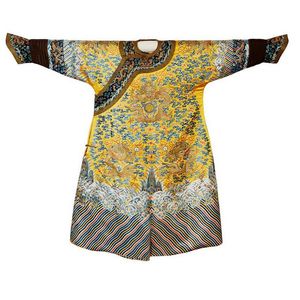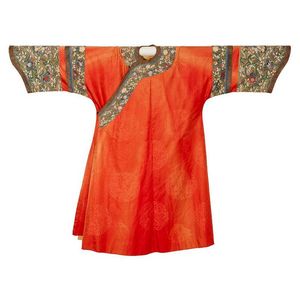Qing Dynasty Imperial Prince's Dragon Robe
You must be a subscriber, and be logged in to view price and dealer details.
Subscribe Now to view actual auction price for this item
When you subscribe, you have the option of setting the currency in which to display prices to $Au, $US, $NZ or Stg.
- Circa - A Latin term meaning 'about', often used in the antique trade to give an approximate date for the piece, usually considered to be five years on either side of the circa year. Thus, circa 1900 means the piece was made about 1900, probably between 1895 and 1905. The expression is sometimes abbreviated to c.1900.
- Ming Dynasty - The Ming Dynasty was a ruling dynasty of China from 1368 to 1644. It succeeded the Yuan Dynasty and preceded the Qing Dynasty. The Ming Dynasty was established by Zhu Yuanzhang, a former Buddhist monk who became a rebel leader and eventually overthrew the Mongol Yuan Dynasty. During the Ming Dynasty, China experienced a period of relative stability and prosperity. The government was centralized and bureaucratic, with the emperor at the top of the hierarchy. The Ming Dynasty is known for its cultural achievements, including the development of porcelain, the invention of movable type printing, and the construction of the Great Wall of China.
- Important - Important is a word used in the antique trade to indicate an object should be ranked above other similar objects, and is therefore more valuable.
The object could be considered important because it is by a famous designer or maker, has been shown at a major exhibition, is of exquisite workmanship, is rare or is a "one-off", was made for an important patron, and so on.
Even further up the pecking order are objects that are described in catalogue descriptions as highly important or extraordinarily important. - Qing Dynasty - The Qing Dynasty was the last imperial dynasty of China, ruling from 1644 to 1912. It was established by the Manchu people, who originated from the northeastern region of China. The Qing Dynasty was preceded by the Ming Dynasty and followed by the Republic of China.
This item has been included into following indexes:
- Oriental textiles & costume, Chinese
Visually similar items

A Chinese twelve symbol Emperor's semi-formal court robe, Jifu, Qing Dynasty (1644-1911), circa 1850, This robe made for the Emperor, is beautifully decorated with the twelve symbols of Imperial authority, arranged discreetly among a number of other symbol

An embroidered blue-ground 'nine dragon' robe, Qing dynasty, 19th century the blue ground embroidered with nine gold dragons in pursuit of flaming pearls amidst scrolling clouds, with bats carrying wan symbols and cranes in flight interspersed with the an

An impressive Chinese Imperial yellow dragon robe, (Longpao Jifu), Qing Dynasty (1644-1911), Daoguang period (c1820), This excellent and rare Manchu nine-dragon robe, has been embroidered with the finest silk and couched gold-wrapped thread on a rich satin

A Chinese red silk Kesi ladies Informal robe, 19th century, decorated with an evenly spaced monochrome pattern of round medallions, enclosing a pair of five-clawed dragons in profile contesting a flaming pearl, set against lotus scrolls. The border at the
